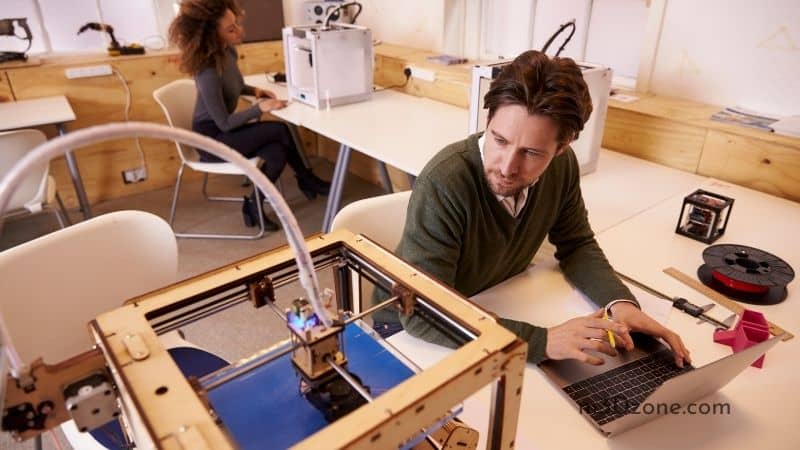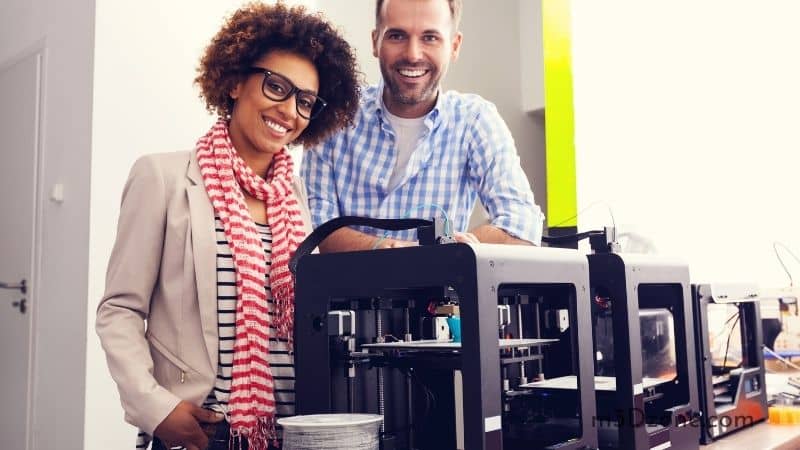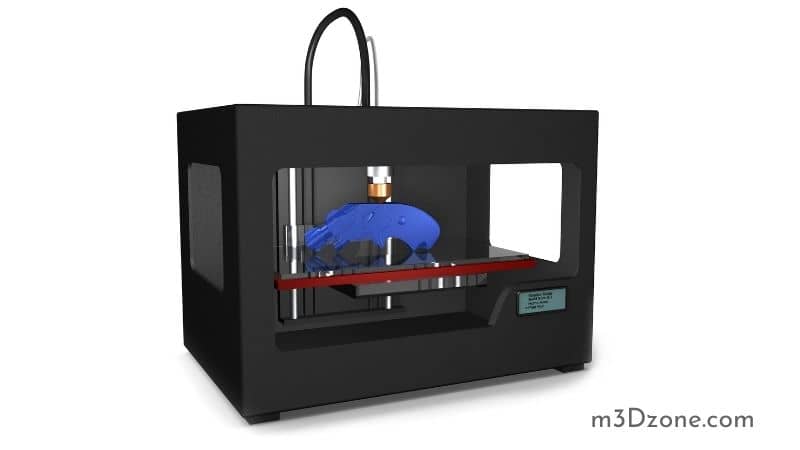Do you have an image in mind that you want to create? 3D Printing gives you a platform to make objects from your imagination easily. Whether you work in the field of medicine, education, architecture, or any other technology-driven field, 3D Printing often comes in handy.

So, what is 3D Printing? Read through this article and get the right answers to your 3D printing questions.
In simple words, 3D printing is the process of making 3D models using 3D printing devices. As you extrude plastic filament from the 3D printing device of your choice, you will build three-dimensional objects one layer after another. With a high-quality 3D printer, you will be able to create new 3D models rapidly without omitting vital details.
Quick Navigation
- What Is 3D Printing and How Does It Work?
- What Is 3D Printing Used For?
- So, How Does a 3D Printer Actually Work?
- Materials Used in 3D Printers
- 3D Printing Technology for DIY
- 3D Printers in Medicine
- 3D Printing Technology in Manufacturing
- 3D Printing Technologies in the Food Industry
- 3D Printers and Guns
- 3D Printers in Education
- Conclusion
What Is 3D Printing and How Does It Work?
Many people often refer to 3D printing as additive manufacturing. They refer to it as additive manufacturing because a person can make three-dimensional objects from a carefully created computer file.
When you have a 3D printer, (FDM) fused deposition will be easy since you will have a specific pattern to extrude plastic filament on one layer at a time. Here, the computer-aided design you make will be precise with fine details since the previous layer’s filament builds a foundation for your next layer.
Related: How Does A 3D Printer Work?
Through the additive process, a person can create 3D objects. You lay down layers of raw material that follow each other in a predetermined pattern. Every layer you add to your 3D model appears as a slice of the 3D model with different layer thickness.
3D Printing is distinct from subtractive manufacturing, contrary to what many people believe. In subtractive manufacturing, you will be cutting out a piece of either plastic or metal from an object.

On the other hand, 3D Printing uses additive manufacturing processes to create three-dimensional models. Binder jetting and laser sintering are some of the additive manufacturing 3D printing technologies at your disposal.
Through selective laser sintering, an individual can sinter material in powder form using a laser as the power source.
The selective laser sintering 3D modeling technology automatically aims the laser at predetermined spots to solidify the material. The end product is an outstanding model. With this printing method, you don’t require as much material as you would if you were using traditional manufacturing methods.
Similarly, direct metal laser sintering (DMLS) helps you to create a metal part from your computer-aided design directly.
Related: 3D Printer vs. Laser Cutter
-
Qualities of 3D Printing
You make 3D objects through fused deposition modeling rather than cutting objects from a block or material.
Since you create 3D models by adding layers of filament to each other, it is necessary to convert the computer file into slices for your printer.
3D Printing requires a few hours or days to make a complete 3D object. The time taken depends on the size of your model and its complexity.
The cost of manufacturing a three-dimensional object depends on the material. If you create a small figurine, the material’s price will not be the same as making a vehicle prototype.
-
How Does 3D Printing Work?
The same way you print a document using a document printer, 3D Printing requires you to have your desired object’s digital design file.
For regular document printing, a PDF or DOC file does the job. 3D Printing, on the other hand, utilizes STL files. This means that if you want to print something in a 3D printer, you must first create a digital file encoding your design.
Alternatively, you can download the STL file of your desired design. Please save the file on your computer to read the digital file and prepare it for printing.
You will then need to select a material for printing. ABS plastic filament or PLA filament works best. Now lead the filament into your 3D printers. Upon receiving your print command, your computer will send instructions to your 3D printers to print the model in the STL file.
-
3D Modeling Software
The best way to create a detailed model is by first creating a digital model. 3D software comes in handy to develop these models. If you are a beginner, Tinkercard 3D modeling software will help you a great deal.
With 3D software, you turn your imagination into something you can share with other people. You are also able to export the model in an STL or OBJ printable file.
Once you have exported the file, you will move to the next step, which is slicing. Here, you will need slicing software to slice up the model into numerous layers. You will then feed the file to your 3D printer via Wi-Fi, USB, or SD and expect a finished 3D project in a few hours or days, depending on the model’s size.
What Is 3D Printing Used For?
3D Printing is used to create 3D objects of different complexities with ease without leaving out essential details.
With technological innovations, more manufacturers are inventing smaller models of 3D printers. Today, you can buy a small, cheap, and easy-to-use model and place it on your office desk.
There is a wide range of reasons why you need to invest in a 3D printer. Look at it from this angle; your child wants a doll or figurine; instead of buying, print one that your child fancies. You can even ask your kids to contribute to developing the design.
You might like: 3D Printing History Timeline
If you have seen an exciting design of plates in a friend’s house, a 3D printer allows you to create yours. 3D printers use a plastic filament to help you in printing 3D models of the plates. You can either replicate the design you see or add a few personal touches.
Sometimes door handles break unintentionally. In case yours breaks, it would be better to create a new one from the comfort of your workstation. The manufacturing process is cheaper since you will only need small amounts of ABS filament or any other 3D printing filament to make whichever spare parts you want.
Suppose your remote fell and broke; you can 3D print a replacement. So you see, the uses of 3D printers are only limited to your capabilities and imaginations; there are a few other factors.
If you are a fashion enthusiast, 3D printing technology is a must-learn. The ideas you have about how a piece of jewelry should look are easily shared with 3D modeling. You can also make the same jewelry pieces and make a fortune selling them.
So, How Does a 3D Printer Actually Work?
A 3D printer works by heating the material you feed it with then fusing it one layer to create 3D objects or things in the process. Once the material has been heated to its melting point, the 3D printer will extrude and deposit it on specific spots according to the digital design.
You don’t want to create objects that are not to your satisfaction, right? Therefore, you must make sure that you translate the software dimensions to the precise real-work measurements when printing.
You also need to align the printer’s print head, extruder hardware, and pulleys. Once you have these components aligned, you are ready to begin printing high-quality objects.
The individuals that use their 3D printers to make figures with resin use laser technology. Laser technology solidifies one layer of filament after the other giving you an amazingly finished 3D figure.
Even though resin additive 3D printing is expensive compared to non-resin printing, it produces more complex objects. Non-resin 3D printing mostly makes use of food, plastic or ceramic materials.
-
The 3D Printing Process (3 Easy Steps)
Operating a three-dimensional printer demands you be a little more skilled than printing ordinary 2D prints. Here is the 3D printing process that you need to learn to create impressive 3D prints.
- First, use software of your choice to develop a 3D model. This model must include all the details you want to have on your final object. If you can create the model, you are free to download a free-to-use one.
- The second step is preparing the model for printing. Here, you double-check all aspects of the 3D model. One of the vital aspects you need to look at here includes being watertight to ensure there are no gaps in the model.
- In the third step, convert your model into a G code. The process is as easy as exporting the 3D model in STL file format. Your computer can understand a G code and print an error-free object.
Lastly, adjust your 3D printer where necessary as you print each layer of your 3D models.
Materials Used in 3D Printers
Different 3D printing devices use other printing materials. For non-resin 3D printer users, the most appropriate material is ABS plastic or PLA plastic. Once the plastic has been heated, it becomes flexible. This gives you the power to bend it in various shapes as demanded by the object you are creating.
Other 3D printers make use of metal wire. If you are using these 3D printers, you can make metallic objects rather than plastic ones.
There is another type of modern 3D printer that uses food and ceramic materials to print. You will need to feed the material you use into your 3D printers before making any prints.
Resin 3D printers (or SLA printers), on the other hand, need custom formulated plastic resin to make objects. Whenever laser light is directed on a specific spot on the resin, it causes it to harden, giving you a robust object.
Plastic is not the only material that you can use in 3D printers. You can also use nylon, wood, or metal in a desktop printer.
Among the things you need to have in mind when using wood and metal filaments is that they are not purely wood or metal, respectively. These materials are plastics that have been fused with the advertised material.
3D Printing Technology for DIY
Innovators worldwide are making efforts to develop 3D printers that are easy to use even at home. Some have already been manufactured and are being used by many individuals everywhere.
If you come from an area with a modern library, you can access 3D printers to learn from. You will get the basic skills you need to get started on 3D Printing.
With the skills you learn, you can create several items such as teacups, plates, tiles, among other things. 3D printers are safe to use, so you don’t have to be worried about doing three-dimensional printing yourself.
3D Printers in Medicine
Medicine is another field benefiting from 3D printing technology. Experts are now using SLA printers as a way of making medical supplies inexpensively.
Some of the medical supplies that people use made using 3D printers are dentures, hearing aids, and prosthetics. It doesn’t matter how you lose your teeth; you can get a replacement at just a few bucks.
Similarly, people with hearing problems are making use of hearing aids that have been printed out using 3D printers.
The usefulness of 3D printers goes as far as helping out in surgical cases. Some people have had their faces reconstructed with the help of 3D printers.
3D Printing Technology in Manufacturing
Soon, people will be able to mass-produce cars using 3D printing technology. For instance, an old car model can be manufactured using 3D printed material or components with the same shape and size. You will have a modern engine with better power and less fuel consumption.
Through the same printing processes, rapid prototyping of cars is easy.
Making cars are not the only things 3D printing is helping the manufacturers with. Fighter jets have been manufactured using components printed out in 3D printers. The price is fair compared to buying fighter jets manufactured using traditional manufacturing methods.
3D Printing Technologies in the Food Industry
Here is a fun fact! Additive processes come in handy in making 3D printed food. There is a wide range of foods that can be printed using layers of edible printing materials.
Some of the foods being printed using 3D printers include layers of cakes, pasta, chocolate layers, and pizza. The taste of these foods doesn’t differ from that of the foods prepared using the traditional methods.
3D technology in the food industry is not only geared towards merely making food. No, environmental conservation is made possible with the 3D Printing of food. Each layer of food you create contributes to conserving the environment. You don’t need to use much of the natural resources in food production.
Another advantage of food 3D printing is the reduced price of buying food.
3D Printers and Guns
One of the most controversial or perhaps misunderstood three-dimensional printing applications is when it is associated with guns. Well, a 3D printer’s print head can be directed to make an object such as a gun.
You will need to design layers of a digital model of the gun. As you print these layers one layer after the other, you must be accurate to have an explicitly printed gun.

There are concerns, however, being raised about using three-dimensional printing technology to make guns. Individuals know how to create their weapons. This is because they only need to apply the straightforward principle of printing filament layers to make a 3D object.
The safer alternative is creating a lightsaber instead of a gun.
3D Printers in Education
With these technologies, children and adults can now create any object. Innovation has improved since anyone can develop a prototype of anything so long as they will print it out one layer at a time.
You can also learn how to use a milling machine and use it to make whatever objects you decide on. If you have a model that needs to be printed out then cut at the cross-section, you will learn all the techniques you need in this kind of 3D Printing.
Conclusion
3D Printing is not as complicated as some people would think. All you need is to understand the 3D printing technologies, including SLA printing, that you are comfortable using. You will then design a digital model of your desired object and command your 3D printers to print it.
Recommended Reading
SLS vs SLA in 3D Printing. What Is the Difference?
SLS vs SLA. Both technologies belong to additive manufacturing. SLS belongs to the powder bed fusion family, while SLA relates to the liquid resin family.
Should You Invest In a 3D Printer?
Should you invest in a 3D printer? Yes! You should invest in a 3D printer because it's a good investment. Using your creativity you can print all...
Nylon vs PETG In 3D Printing. What To Choose & Why?
Nylon vs PETG. In general, Nylon is a more versatile filament than PETG. However, PETG offers superior resistance to heat, moisture, and chemicals. See more!
